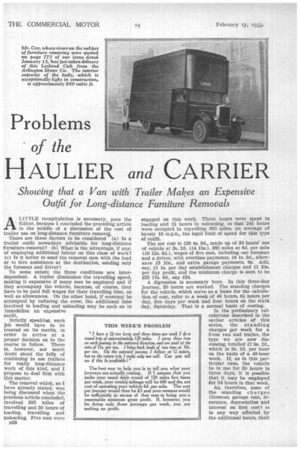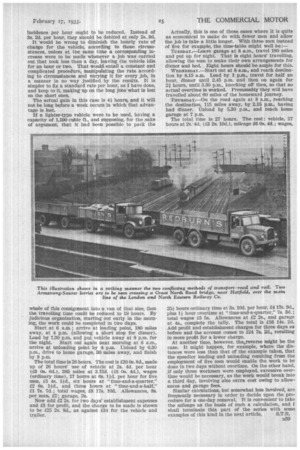Problems
Page 52

Page 53

If you've noticed an error in this article please click here to report it so we can fix it.
of the
HAULIER and CARRIER
Showing that a Van with Trailer Makes an Expensive Outfit for Long-distance Furniture Removals
ALITTLE recapitulation is necessary, pace the Editor, because I concluded the preceding article in the middle of a discussion of the cost of trailer use on long-distance furniture removaj.
There are three factors to be considered (a) Is a trailer outfit nowadays advisable for long-distance furniture removal? (b) What is the advantage, if any, of employing additional labour on this class of work? (c) Is it better to send the removal men with the load or to hire assistance at the destination, sending only the foreman and driver?
To some extent the three conditions are interdependent. A trailer diminishes the travelling speed, making it expensive if many men be employed and if they accompany the vehicle, because, of course, they have to be paid full wages for their travelling time, as well as allowances. On the other hand, if economy be attempted by reducing the crew, the additional time involved in loading and unloading may be such as to immobilize an expensive outfit.
Strictly speaking, each job would have to be treated on its merits, in order to arrive at a proper decision as to the course to follow. There Is, however, not much doubt about the folly of continuing to use trailers for really long-distance work of this kind, and I propose to deal first with this matter.
The removal which, as I have already stated, was being discussed when the previous article concluded, involved 385 miles of travelling and 30 hours of loading, travelling and unloading. Five men were
engaged on this work. Three hours were spent in loading and 21 hours in unloading, so that 24i hours were occupied in travelling 385 miles, an average of barely 16 m.p.h., the legal limit of speed for this type of outfit.
The net cost is £26 4s. 9d., made up of 80 hours' use of vehicle at 3s. 2d. U4 15s.), 385 miles at 6d. per mile CEO 12s. 6d.), wages of five men, including one foreman and a driver, with overtime payments, £8 Is. 3d., allowance £3 10s., and extra garage payments, fis. Add, say, is. per day establishment charges and £1 10s. per day profit, and the minimum charge is seen to be £33 17s. Od., say £34. A digression is necessary here. In this three-day Journey, 30 hours are worked. The standing charges for the vehicle, which serve as a basis for the calculation of cost, refer to a week of 48 hours, 8i hours per day, five days per week and four hours on the sixth day, Saturday. That is a normal basis of costing. In the preliminary calculations described in the earlier articles of this series, the standing charges per week for a 5-ton van and trailer, the type we are now discussing, totalled £7 Os. 2d., which is 3s. 2d. per hour on the basis of a 48-hour week. If, as in this particular case, the vehicle be in use for 30 hours in three days, it is possible that it may be employed for 54 hours in that week.
As, therefore, none of the standing charges (licences, garage rent, insurance, depreciation and interest on first cost) -is in any way affected by the additional hours, their Incidence per hour ought to be reduced. Instead of 3s. 2d. per hour, they should be debited at only 2s. 9d.
It would be wrong to diminish the hourly rate of charge for the vehicle, according to these circumstances, unless at the same time a corresponding increase were to be made whenever a job was carried out that took less than a day, leaving the vehicle idle for an hour or two. That would entail a constant and complicated procedure, manipulating the rate according to circumstances and varying it for every job, in a manner in no way justified by the results. It is simpler to fix a standard rate per hour, as I have done, and keep to it, making up on the long jobs what is lost on the short ones.
The actual gain in this case is 41 hours, and it will not be long before a week occurs in which that advantage is lost.
If a lighter-type vehicle were to be used, having a capacity of 1,100 cubic ft., and supposing, for the sake of argument, that it had been possible to pack the
whole of this consignsnent into a van of that size, then the travelling time could be reduced to 19 hours. By judicious organization, starting out early in the morning, the work could be completed in two days.
Start at 6 a.m.; arrive at loading point, 180 miles away, at 4 p.m. (allowing a short stop for dinner). Load by 7.30 p.m. and put vehicle away at 8 p.m. for the night. Start out again next morning at 6 a.m., arrive at unloading point by 4 p.m. Unload by 6.30 p.m., drive to home garage, 30 miles away, and finish by 8 p.m.
The total time is 26 hours. The cost is 120 Os. 8d., made up of 26 hours' use of vehicle at 2s. 4d. per hour (£3 Os. (3d.), 385 miles at 3.75d. (£6 Os. 4d.), wages (ordinary time), 17 hours at 6s. lid, per hour for five men, 15 4s. lid., six hours at " time-and-a-quarter," £2 6s. 14d., and three hours at " time-and-a-half," £1 7s. 7d.; total wages, £8 17s. 10d. Allowances, 8s. per man, £2; garage, 2s.
Now add £2 2s. for two days' establishment expenses and £3 for profit, and the charge to be made is shown to be £25 2s. 8d., as against £34 for the vehicle and trailer. Actually, this is one of those cases where it is quite as economical to make do with fewer men and allow the job to take a little longer. With three men instead of five for example, the time-table might well be :
TriEsna.v..-Leave garage at 8 a.m., travel 180 miles and put up for night. That is eight hours' travelling, allowing the men to make their own arrangements for dinner and bed. Eight hours should be ample for this.
WEDNESDAY.-Start out at 8 a.m., and reach destination by 8.15 a.m. Load by 1 p.m., travel for half an hour, dinner until 2.45 p.m. and then on again for 2i hours, until 5.30 p.m., knocking off then, so that no actual overtime is worked. Presumably they will have travelled about 60 miles of the homeward journey.
• THURSDA.Y.-On the road again at 8 a.m., reaching the destination, 115 miles away, by 2.15 p.m., having had dinner. Unload by 5.30 p.m., and reach home garage at 7 p.m.
The total time is 27 hours. The cost; vehicle, 27 hours at 2s.4d. (£3 2s. 10,d.), mileage £6 Os. 4d.; wages, 251 hours ordinary time at 3s. 10d. per hour, £4 17s. 9d., plus ii hour overtime at " time-and-a-quarter," 7s. 3d.; total wages £5 5s. Allowances at £2 2s., and garage at 4s., complete the tally. The total is £16 14s. 2d. Add profit and establishment charges for three days as before and the account comes to £24 7s. 2d., resulting in more profit for a lower charge.
At another time, however, thejeverse might be the case. It might happen, for example, where the distances were less than that of the example taken, that the speedier loading and unloading resulting from the employment of five men would enable the work to be done in two days without overtime. On the other hand, if only three workmen were employed, excessive overtime would be necessary, as the work would break into a third day, involving also extra cost owing to allowances and garage fees.
Similar calculations, but somewhat less involved, are frequently necessary in order to decide upon the procedure for a one-day removal. It is convenient to take the mileage as the basis of such a calculation, and I shall terminate this part of the series with some
examples of this kind in the next article. S.T.R.




























































































